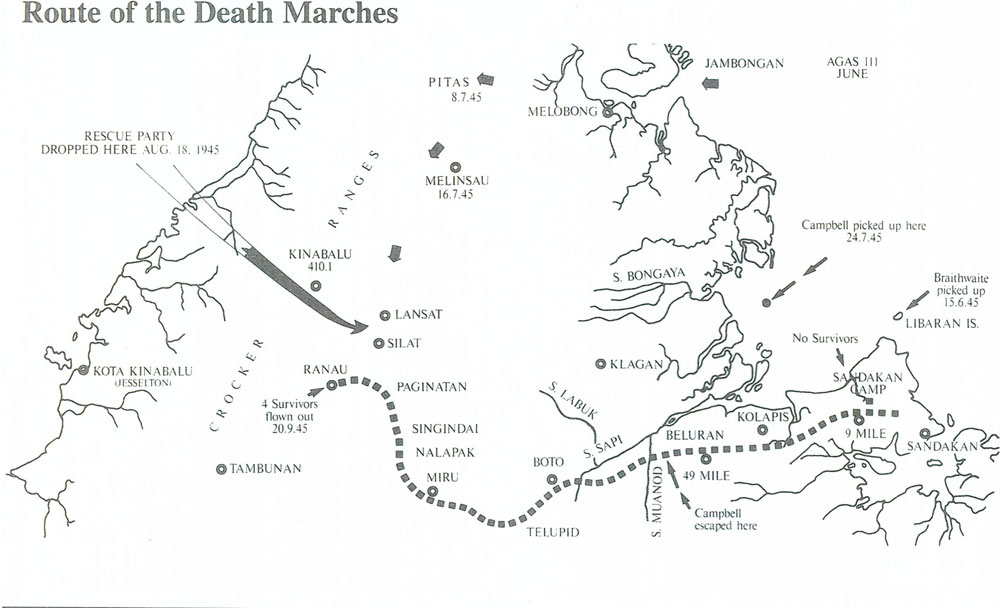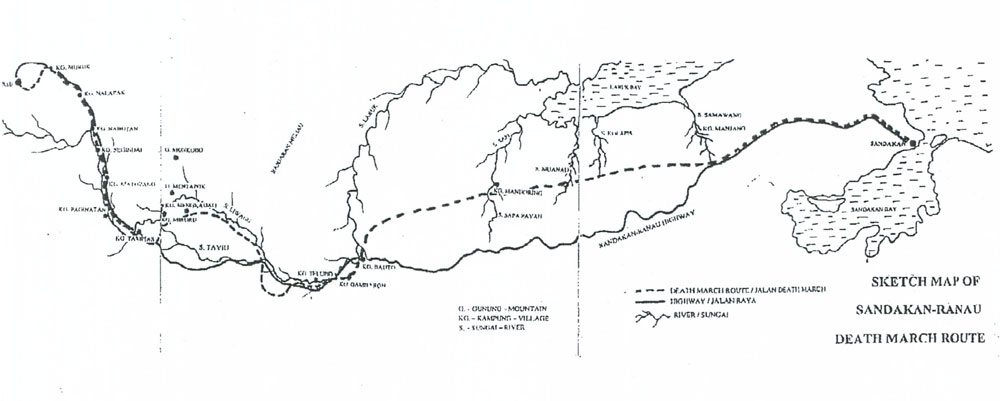Sandakan – Borneo
The Sandakan Memorial Trek
The Sandakan Death March was a tragic episode during World War II that involved the forced march of Australian and British prisoners of war in Borneo, Malaysia, by the Japanese Imperial Army during the early part of 1945.
Following the fall of Singapore in 1942, the Japanese captured around 2,700 Allied soldiers and transferred them to Sandakan POW camp.
The prisoners endured harsh living conditions, malnutrition, and brutal treatment.
In January 1945, as the war approached its end, the Japanese decided to move the remaining prisoners on a series of gruelling marches to Ranau, approximately 260 kilometres away.
The marches were marked by extreme brutality, and only six Australians survived.
This brutal chapter in history serves as a poignant reminder of the sacrifices made by the Australia Diggers, highlighting their bravery and resilience in the face of overwhelming adversity.
The Diggers were well-regarded for their fighting spirit, resourcefulness, and camaraderie. Throughout the war Australian soldiers fought alongside their British and American allies, often facing challenging conditions in unfamiliar territories.
The events of the Sandakan Death March exemplify the immense courage and resilience displayed by the Australia Diggers as they endured unimaginable hardships and remained steadfast in their commitment to their country and fellow soldiers.
ANZAC Day serves as a poignant reminder of the tremendous contributions made by the Diggers and honours all Australian servicemen and women who have served in conflicts around the world. The Sandakan Memorial trek remains a crucial part of this commemoration, reminding the nation of the brutalities of war and the bravery of those who endured them.
Through the remembrance of such events, Australians continue to recognize the profound impact of war on individuals, families, and society, fostering a commitment to peace and unity for future generations.
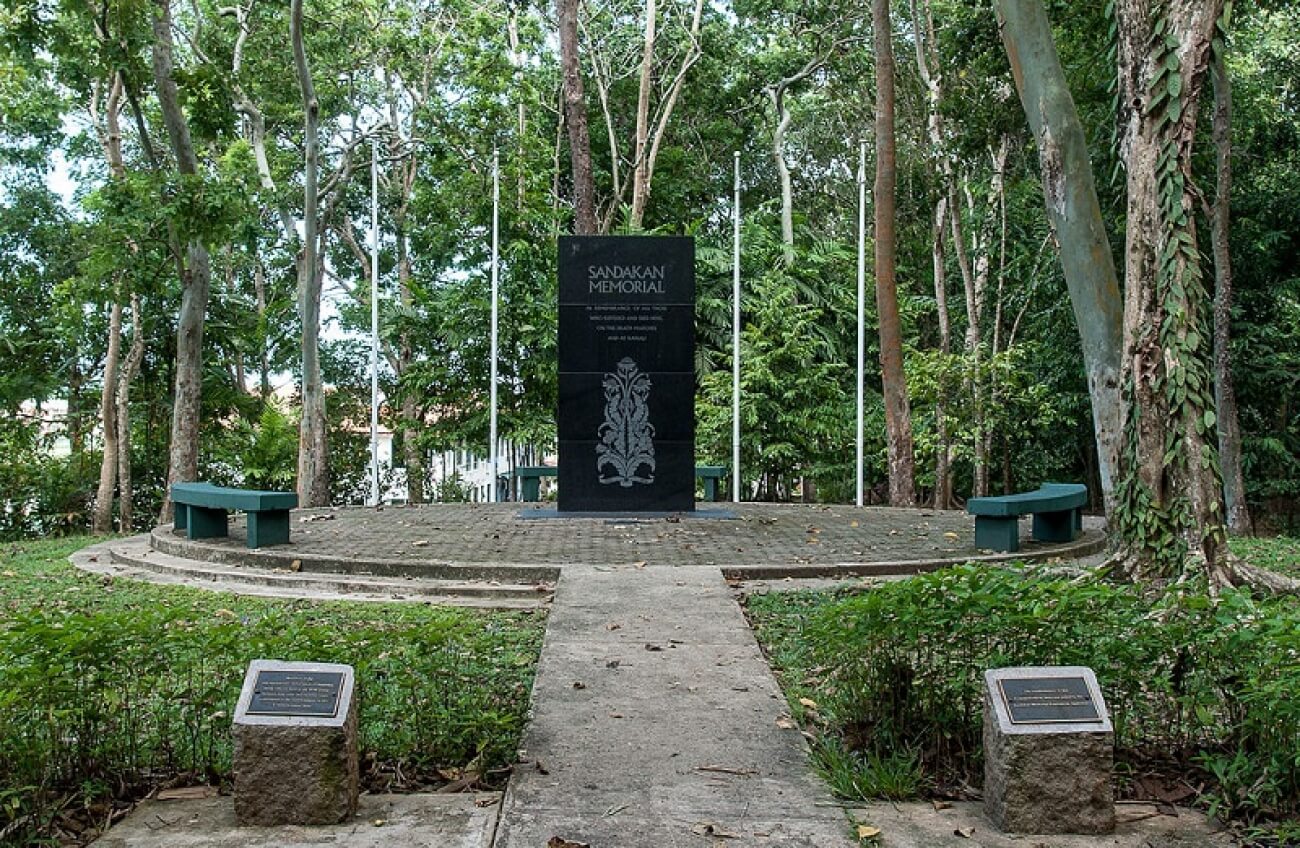
ANZAC Day - Sandakan Memorial Trek - 8 Nights, 9 Days
Sandakan is one of the most tragic Australian stories of World War Two. But it’s also one of our most heroic.
After 79 years, you can walk the Sandakan Death March track in the footsteps of those heroes.With Sandakan Spirit as your trekking company, you’ll be participating in both a personal discovery experience and an historic Borneo adventure.

ANZAC Day - Sandakan Memorial Trek Plus Mt Kinabalu Climb - 10 Nights 11 Days - $4,795 PP
Sandakan is one of the most tragic Australian stories of World War Two. But it’s also one of our most heroic.
After 79 years, you can walk the Sandakan Death March track in the footsteps of those heroes.With Sandakan Spirit as your trekking company, you’ll be participating in both a personal discovery experience and an historic Borneo adventure.
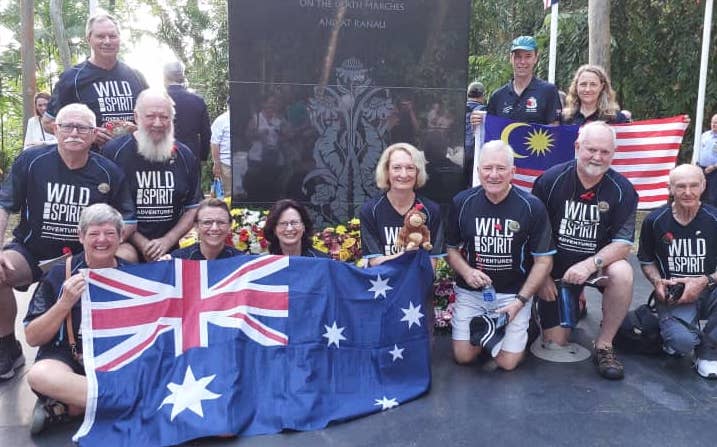
Sandakan Memorial Trek & Mt Kinabalu Climb (Including Sandakan Day Services) 11 Days - 10 Nights - $4295 pp
Sandakan is one of the most tragic Australian stories of World War Two. But it’s also one of our most heroic.
After 79 years, you can walk the Sandakan Death March track in the footsteps of those heroes.With Sandakan Spirit as your trekking company, you’ll be participating in both a personal discovery experience and an historic Borneo adventure.
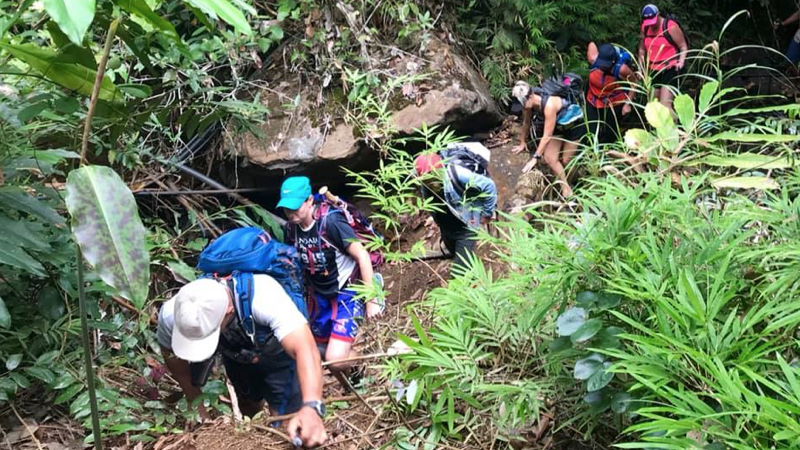
Sandakan Memorial Trek - 8 Nights, 9 Days - $3,545 PP
Sandakan is one of the most tragic Australian stories of World War Two. But it’s also one of our most heroic.
After 79 years, you can walk the Sandakan Death March track in the footsteps of those heroes.With Sandakan Spirit as your trekking company, you’ll be participating in both a personal discovery experience and an historic Borneo adventure.
About
Wild Spirit Adventures is owned by Wayne Wetherall who specialises in small group tours designed to provide you with lifelong memories to Sabah, Borneo Malaysia.
Wayne Wetherall, Managing Director of trekking company Kokoda Spirit and Wild Spirit Adventures has walked the Sandakan Death March Track on 10 occasions and has been very fortunate to meet a number of the old local people from Borneo and hear first hand their experiences of the Sandakan Death Marches.
Our trekking partners are Dusuns, direct descendents of the carriers and locals that helped the POW’s. We stay at local villagers, purchase our fruit and vegies ensuring that the local communities benefit from tourism.
Over the past two journeys Wayne and his team of local Dusun’s, who are direct descendents of the carriers and villagers along the track have meticulously, using the latest in GPS mapping technology and old fashion hard work we were able to faithfully piece together as close as it is possible to get to the original route.
Our treks across the Sandakan Death March route faithfully as close as possible follow the original route.
We avoid using short cut or alternative treks that are logistically easier to ensure you see the real Borneo, the real Sandakan Death March Route. We use a variety of accommodation on our treks including camping next to Rainforest Rivers and staying in traditional Dusun Villages along the way, this gives you a great chance to embrace the traditional culture and mix with the locals and hear firsthand the stories of their forefathers.
If you are comparing Sandakan trekking companies, make sure you are on the correct route.
We have over 10 years experience in the design and delivery of a wide range of challenging expeditions and adventure based programs around the world.
Wayne is also the owner of Kokoda Spirit, which is an Australian and PNG based company specialising in treks across the Kokoda track in PNG.
Wayne has been developing adventure programs, tours and itineraries to show case the wonders and beauty of Sabah, including the infamous Sandakan Death March. Wayne has the flexibility and local experience to tailor an itinerary and program to suit your individual or group requirements.
Waynes goal is to deliver a world class Sandakan and Borneo experience while ensuring all stakeholders including the local villages and communities benefit from tourism.
Our journeys are a mix of culture, soft adventure, challenge and most of all, safe and enjoyable experiences.
Our tours are designed with the aid of local people enabling Wild Spirit Adventures to support the diverse cultures in which we operate. Our philosophy of providing economic and environmentally sustainable practices in the countries we visit has enabled us to develop long lasting relationships with the local peoples.
Our Sandakan partner is reputable, an experienced operator who are proud of their culture and history. This relationship will allow you the opportunity to not just experience another country, but to experience people, their culture, and their environment. You are a part of the journey, not just an observer. You will gain a deeper understanding of place and people providing everlasting memories of your own international “wild spirit”.
Our Sandakan adventures ensure that our impact is minimal by adhering to a self imposed code of conduct. This not only involves adhering to the laws, guidelines and regulations of the countries we visit, but also operating in a socially and environmentally responsible manner. It is our own backyard and we need to look after it.
Our staff are passionate about people and about providing people with everlasting memories of the places we visit. They live and have families in the beautiful areas we operate in. Wild Spirit Adventures encourages and assists our guests in learning about the country, its culture, religion and its customs, resulting in a much more informed experience.
April
August
September
April
August
September
Sandakan Death March Overview & History
Sandakan is regarded as one of our worst wartime tragedies. Beside the fact that of approx. 3000 Prisoners of War, only 6 would survive to tell the story, and that attempts to rescue the POWs were at best disorganized and at worst less that serious, the overwhelming feeling is that this tragedy exposed the very worst of a ruthless enemy and the very best of individual POWs. Their stories are worth knowing and sharing.
As Dame Mary Gilmore (Australian writer and Poet) has said. “They are not dead; not even broken.
Only their dust has gone back home in the earth; For they, the essential they, shall have rebirth Whenever a word of them is spoken.”
At the fall of Singapore in Feb 1942, over 100 000 allied troops from a number of countries were held prisoner by the Japanese Imperial Army in the Changi Region of Singapore. In the early days, life wasn’t too bad for the POWs, as they could wander the area without strict supervision or treatment, but as the war moved on to other Pacific area, the Japanese identified a need to use the POWs as slave labour to build airstrips and rail links. This meant that some POWs would be moved to other sites, like Thai- Burma Railway and to Borneo.
On July 8, 1942, approximately 1500 POWs were invited to travel to a “land of milk and honey”, where food was plentiful, and life would be less crowded and easier. The reality would be far different to this. At later dates, more POWs would be sent to Sandakan. The first POWs were housed on Berhala Island in Sandakan Harbour. Eventually all would be sent to Sandakan mainland to the POW camp that we will visit on our trek.
For the next 3 years, the POWs would be subjected to cruel treatment that included starvation, withholding medical supplies and treatment and savage beatings for any minor discretions. Each day they would march the 4 kms to the site of the airstrip and work with crude tools to build and maintain this for Japanese planes. Keith Botterill, one of the only 6 to survive, describes in his own words what life was like in the Camp.
“I was confined in the cage at Sandakan for 40 days and 40 nights, during which time I was bashed every day. I was not allowed to have a wash or a shave all the time I was imprisoned and was seven days without food. On another occasion I was locked up in the cage for twelve days for breaking away from the aerodrome to get tapioca roots; I was caught coming back by the Koreans. On the occasion of my first imprisonment, I had broken into the Q. M. store for food for the sick. After the 40 days were up, I had scabies all over my hand. I had no clothes at all except a lap-lap. Each morning those in the cage were taken and given what the Japanese called “P.T.” This consisted of a severe bashing. Men had to be carried back into the cage crying; some collapsed but a bucket of water was thrown over them to bring them too again. At the time I was in the cage, there were 17 others confined. The cage was about nine feet by 18 feet, and we could not all lay down together; when we lay on our sides close together, four still had to sit up.”
As the war started to turn badly against the Japanese, a decision was made to move the POWs inland to Ranau, some 260 km away. The Japanese explanation for this was to protect the POWs from the increasingly frequent allied bombing. Reality would tell us that to march sick and undernourished men through thick jungle over mountains would amount to a death sentence for all but a few.
The local Dusan people who were instructed to create the track to Ranau, were of the belief that it was only for retreating Japanese troops and so they made the track as difficult as possible, moving away from water and including mountainous climbs through thick jungle. This would result in impossible conditions for weak, starved and sick POWs.
The First March began on Jan 29, 1945. Some 455 of the fittest POWs set off walking, carrying their own meagre belongings as well as supplies for their masters. The journey took 9 to14 days. Many would die on the way. Some would fall down from exhaustion and starvation and were subsequently murdered. By June 26 only 5 Australians and 1 British soldier were still alive. Keith Botterill once again describes in his own words what that March was like.
“In February 1945 we were given three days’ notice to leave Sandakan at the rate of 50 a day, for Ranau. Altogether there were 850 Australians and 120 English, and I was in the third party. When I left two parties had already gone. The Japanese who were with us on the march were a lieutenant, a sergeant-major, a corporal, a lance-corporal and about 15 privates; we were made to carry their ammunition and rice as well as our own clothes, blanket, groundsheet and provisions. For three days 40 of us had only six cucumbers between us but generally we had a little bit of rice which was just sufficient to keep us alive. Men dropped out from the march as they became too weak to carry on and they were immediately shot.
I saw four men shot when they fell out and this was done by the Japanese sergeant major. On one occasion an Australian sergeant could not carry on and fell out. He seemed to go off his head and was grabbing Sgt-Maj. Warrington and begging him to shoot him. A number of mates were bayoneted, by the Japanese, 20 miles from Ranau. They were too weak to carry on and fell out. I saw the bayoneting myself; the men were on the ground at the time. The corporal and myself used to go into the gardens for tapioca which we would cook up and make a decent meal of, so I was one of the fittest men in the camp. On this occasion, of the bayoneting and shooting, Shear was on the ground calling out “Don’t shoot me” and putting his hands up, but nevertheless he was shot and left lying on the ground.”
The Second March began on May 29 with 536 POWs. Only 183 got to Ranau.
The Third March began on June 9 with only 75 POWs capable of starting from approx. 250 POWs left at Sandakan. None of these 75 would last beyond the 50 km mark. The rest of the POWs were taken out of their huts and their huts were burnt. Those who did not die of “natural causes” were shot. None would remain alive in Sandakan.
Their story would never have seen the light of day, if not for the 6 Australians who escaped.
Private Keith Botterill, Warrant Officer Bill Sticpewick, Private William Moxham, Bombardier Richard Braithwaite, Gunner Owen Campbell and Private Nelson Short were the only survivors.
Was this a Preventable Tragedy?
There have been many statements put forward over the years for both sides of the argument. Indeed, there is evidence that with better intelligence and with a stronger will to succeed, there was an opportunity to at least attempt a rescue. Successful rescues of American POWs in Manila, like Los Banos, where 2146 civilian internees were rescued by a surprise attack of the American 11th Airborne Division. Also 3500 civilian internees were rescued at Santo Tomas, near Manila when a deal was made between American and Japanese Troops. Some 810 POWs and 500 civilians are rescued when the Japanese pulled out of Bilibid Prision as American Troops approached.
In Sandakan, info of POW numbers and their condition was gathered from 2nd and 3rd hand sources. Although Captain Ray Steele, who escaped in May 1943, gave information to authorities, which seems to have been ignored or discounted.
Operation Kingfisher was a planned rescue operation of the POWs in Sandakan Camp that was abandoned in early 1945. The Agas Team on the ground in Borneo incorrectly reported that by April there were no POWs left in Sandakan. This was clearly wrong.
The closeness of an actual attempt can be seen by the fact that Australian paratroopers and Royal Marines were placed on standby for such an operation. The order to GO! was never received. General Thomas Blamey (Commander-in-Chief of Australian Armed Forces) directed blame at General Douglas MacArthur (Supreme Commander – South Pacific Area) for not providing adequate air support. The real truth will never be known.
Their story of suffering and survival will be revealed on the trek. They bear witness to the immense COURAGE, amazing ENDURANCE, undying MATESHIP and total SACRIFICE.
Adventure Sports, Adventure Culture, Adventure Education, Wild Life Safaris.
Sabah Borneo has some of the World’s greatest adventures including the infamous Sandakan Death March. Immerse yourself in an ecological treasure that is breathtaking, serene and thrilling. Whatever your mood, you have paradise in the palm of your hand in Sabah, the adventure land of eco-treasures.
So whatever excites or fascinates you, your children or friends, from mountain climbing, jungle trekking, wildlife safaris, white water rafting, mountain biking, kayaking, diving, fishing, sailing, windsurfing, water skiing, tennis or golf, Sabah promises excitement to fulfil every adventurers and sporting persons wishes and dreams. Sabah Borneo is also the place to experience the culture of this wonderful place, with traditional longhouses and village stays, exotic cuisine, traditional festive celebrations and the incredible “tamu” or local market place shopping experience. Sabah is also home to some amazing, unique and fascinating animals, including the incredible Borneo Elephants, Orang Utan, and Proboscis monkeys.
Why go to Africa when you can have your very own wildlife safari in Borneo. Come trek with us through the pristine Jungle of the lower Kinabatangan River in search of colourful tropical birds, crocodiles, huge monitor lizards, wild pigs, elephants, otters, several species of monkeys, tree snakes. It is also a haven for the Proboscis Monkey, Orang Utan, hornbills and kingfishers.
We pay tribute to our soldiers, the Sandakan Death March is acknowledged as the worst military tragedy for Australia in World War II. Tragic though it is, the story of the Sandakan Death March is an important chapter in the shared wartime history of Australia and Sabah Borneo. We offer treks exploring sections of the Sandakan Death March Route by vehicle and on foot. We visit the haunting 8 mile Prisoner of war camp at Sandakan; explore the Sandakan town including the Catholic Church where the prisoners first stayed on arrival in the area. Our trek across the Sandakan Death March Track takes us too many of the historical and heroic areas along the track, where our Australian Soldiers lost their lives in tragic and barbaric fashion.
Wild Spirit Adventures are dedicated to delivering to you some of the World’s greatest adventure. We are specialist in delivering the ultimate in Adventure Sports, Adventure Culture and Adventure Education. We specialise in tailoring adventure itineraries to suit individual and group requirements. Our itineraries and adventures can be swapped and modified to maximize your adventure.
For those that wish to indulge in the finer things of life, before, during or after their adventures, Sabah has a wealth of 3, 4 and 5 star resorts and hotels to choose from.
All of our adventures can be designed to suit the elite athlete with harder and more challenging adventures or modified to suit school groups, groups or individuals. Our trekking groups are small and personal, with most group sizes only around 8 people allowing for greater flexibility in the itinerary. We can also cater for 1 or 25 travellers.
Why Choose Sandakan Spirit?
We are the other trekking company that our competition talk about and try and emulate.
We carry a full $10 million dollar Public Liability Insurance, you are also protected by the Travel Compensation Fund which confirms the ability of the operator to be financially viable.
Make sure if you are dealing with overseas companies that they cover insurance in Australia and Malaysia and that you are covered under the TCF.
Make sure any operator you use is covered under Australian and Malaysian law.
It is important that you ask your trekking company important questions regarding the Sandakan Death March route that they walk and the itineraries and accommodation that they use.
There are a number of prominent and respected adventure companies offering packages to Borneo and the Sandakan Track, be sure to check out their itineraries, routes and accommodation offered.
Our treks across the Sandakan Death March route faithfully as close as possible follow the original route. Our treks are based on research from the premier and respected authorities on the Sandakan Death March,Don Wall and Kevin Smith.
We avoid using “short cut”,“eco” or alternative tracks that are logistically easier to ensure you see the real Borneo, the real Sandakan Death March Route. We use a variety of accommodation on our treks including camping next to Rainforest Rivers and staying in traditional Dusun Villages along the way, this gives you a great chance to embrace the traditional culture and mix with the locals and hear firsthand the stories of their forefathers.
The most acclaimed authority on the Sandakan Death March and Sandakan POW camp is Don Wall.
Don Wall is a Veteran of WW11, volunteering for service with the AIF, serving with the 2/20 Battalion 8 Division. After the fall of Singapore Don then became a POW.
Don had the full co-operation during his research of Sandakan Death March survivors Keith Botterill, Owen Campbell and Nelson Short. These in-depth discussions covered all aspects of the events of prisoner of war life in Sandakan.
Don wrote his first book Kill the Prisoners way back in 1988 and his revised fourth edition in 1995.
Don also had full access and permission to use the private records of Lt. Col. H.W.S Jackson, MBE (Ret.) in particular records of the recovery of remains, his first hand knowledge of the people of Borneo, those that witnessed the prisoners on the marches and those who saved the lives of the six survivors.
The other prominent authority and author on Sandakan and the Sandakan Death March is Kevin Smith.
Do not be deceived in believing that there has only been one book written about Sandakan and the Sandakan Death March.
Don and Kevin have researched and written excellent books.
We also base our treks on the reports compiled by Veterans of Borneo, Major R.E. Steele, WO W. Wallace and SGT R.J. Kennedy.
Wayne Wetherall, Managing Director of trekking company Kokoda Spirit and Sandakan Spirit has walked the Sandakan Death March Track on 8 occasions and has been very fortunate to meet a number of the old local people from Borneo and hear first hand and record their experiences of the Sandakan Death Marches.
Over the past two journeys Wayne and his team of local Dusun’s, who are direct descendents of the carriers and villagers along the track have meticulously, using the latest in GPS mapping technology and old fashion hard work and intense research we were able to faithfully piece together as close as it is possible to get to the original route.
Trekking the Sandakan Death March route with usis an experience not just a holiday. We see things as an explorer, historian and adventurer.
When you trek the Sandakan Death March with Sandakan Spirit, you’re participating in a personal discovery experience; you are truly living and participating in an historic and monumental Borneo adventure.
Our travel arrangements are by Spirit Holidays – Travel Agents License TAG1611. Make sure your tour company complies with both Australian and Malaysian laws.
Tour Operator Reveals Deadly Past
Wayne Wetherall, the man behind Kokoda and Sandakan Spirit, is doing Australian history a great justice by providing trekkers what is more than likely to be the most accurate track through Borneo that retraces the steps of over 1700 Australian men whom were incarcerated by the Japanese in WWII.
Read the full story of Waynes discovery here
Local Heroes On The March
TWO elderly Malaysians who risked their lives more than 60 years ago to help Allied prisoners of the Japanese during World War II will fly to Sydney next month to take part in a commemoration of the infamous Sandakan death marches.
Read the full story here
Borneo Track Discovery Claim
AN Australian trekker says he has uncovered two new sections of the infamous Sandakan Death March track in Borneo which would help with the preservation of one of the country’s most tragic and heroic wartime histories.
Read the full story on the Herald Sun
FAQ - Sandakan Death March
Sandakan Death March
Kevin Smith Testimonial
Dear Wayne, Your call this morning was most interesting and I thank you for it. I have two maps obtained from a Government office in the early 2000s, although I cannot now recall exactly from whom. They are dated in the mid-70s and I was going to post you copies today. However that will now have to wait until Monday as the place where I have been doing my photocopying has been getting more inefficient by the month. I must now try somewhere else.
The Pow’s Speak About Their Experiences On The Sandakan Death March Track
“All the way along the Sandakan Death March track, we smelt and saw bodies. They were Australian soldier’s bodies from the prisoner’s marches. We could recognise them- some we new personally…
In all my dealings with the Japanese. I have never seen anyone of our chaps after they have been left with the Japs. Once you stopped, you stopped for good.”
“I’d deliberately get out of bed of a morning, off my bunk and I’d go out to aggravate them in some way or other. I never ever let the Japanese beat me, in my mind. Because they beat me bodily, but they never broke my nerve or my heart.”
Governor General Speech
Address By Her Excellency Ms Quentin Bryce AC Governor-General Of The Commonwealth Of Australia
On The Occasion Of The Sandakan Day Memorial service Sandakan 15 August 2010
Today, we gather as nations that share a history, and as friends who share a human story.
The dedication of Sandakan Day ensures that the records and memorials of that history are observed and attended to,
year in, year out, for lifetimes hence.
About Sandakan 1942 – 1945
After the fall of Singapore in February 1942, numbers of Australian and British POWs were brought progressively to Sandakan.
The first large group of Australians about 1500 men to arrive from Singapore was ‘B’ Force. They steamed along the east coast of Borneo on the Ubi Maru and arrived at Sandakan on 17 July 1942.
Lieutenant Rod wells thought the scenery beautiful.
From the sea it’s lovely. With red chalk hills on the side of Berhala Island it really was very impressive. I suppose for a split moment we thought, with a sigh of relief, that here’s some beautiful, peaceful land where there may not be any Japanese.
Sandakan Death March
Jack Sue Did Not Fabricate His Wartime Heroics, Says His Son…..
Theo Fakos Source: Perth Now
CLAIMS that one of Australia’s greatest war heroes, Jack Wong Sue, fabricated key parts of his personal memoir Blood on Borneo have been refuted by a new inquiry.
But Lynette Silver, the historian who made the claims, has refused to back down and yesterday insisted: “There is not a single thing in this report that refutes anything.”
The inquiry, commissioned by the WA World War II hero’s oldest son Barry Sue, found “there appears to be absolutely no justification for calling Jack Wong Sue a liar”.
Parts Of Sandakan Uncovered
New Find On The Borneo Trail….
AN Australian trekker says he has uncovered two new sections of track on the infamous Sandakan death march in Borneo, which would correct the preservation of one of the country’s most tragic and heroic wartime histories.
More than 2400 Australian and British prisoners of war died during World War II working on the track, where they were beaten, tortured and executed. Only six Australians escaped and survived.
Victoria Cross Graves
Robyn Riley – Herald Sun – Sunday July 31, 2011
Help Save Our Victoria Cross Heroes’ Memories…..
The graves of some Victoria Cross war heroes have been left to crumble because of decades of bureaucratic indifference.
And the final resting places of many of Victoria’s bravest soldiers are in danger of disappearing entirely thanks to bureaucratic buck-passing.
Courage Sacrifice
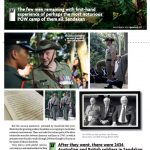
The Most Tragic Australian Stories
SANDAKAN IS ONE OF THE MOST TRAGIC AUSTRALIAN STORIES OF WORLD WAR TWO.
BUT IT’S ALSO ONE OF OUR MOST HEROIC.
After nearly 70 years, you can walk the Sandakan Death March track in the footsteps of those heroes.
With Sandakan Spirit as your trekking company, you’ll be participating in both a personal discovery experience and an historic Borneo adventure.


